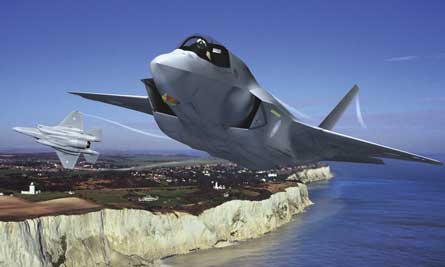The UK’s acquisition of the Lockheed Martin F-35 Joint Strike Fighter has moved a step closer to reality, with the Ministry of Defence having given its so-called Main Gate approval for the construction of two Future Aircraft Carriers (CVF) worth up to £3.9 billion ($8 billion).
To weigh 65,000t, each CVF vessel will deploy an air wing of up to 40 aircraft, typically including 36 short take-off and vertical landing F-35Bs, plus organic airborne early-warning aircraft – currently the Westland Sea King 7 airborne surveillance and control system – and AgustaWestland EH101 Merlin HM1 multi-mission helicopters.
The MoD is expected to later this year sign a manufacturing-phase contract with the Aircraft Carrier Alliance, which includes BAE Systems and Thales UK. The vessels are planned to enter service in 2014 and 2016, respectively, with first steel to be cut in August 2008. While this represents a two-year slippage on earlier projections for the type’s availability, Rear Adm Bob Love, CVF team leader for the UK Defence Equipment and Support organisation, says: “The current CVS [ships] will run on, and there will be no capability gap.”
 |
|---|
© Lockheed Martin |
The new schedule also matches more effectively the likely introduction of the short take-off and vertical landing F-35B, with the UK expected to reach initial operational capability with the aircraft in 2014-15. The UK must make an investment decision next year on ordering its first JSFs, and also to meet its commitment to the Tranche 3 production phase of the four-nation Eurofighter Typhoon programme.
 |
|---|
© BAE Systems |
However, MoD finance director Trevor Woolley says “no decisions have yet been made” on the final phase of the Eurofighter project. “We have to make decisions on where our priorities lie,” he says. “There are always hard choices to be made in defence.”
The carrier announcement coincided with the results of a UK government-wide comprehensive spending review announced on 25 July. The MoD will receive funding worth £106 billion over the three financial years starting from April 2008, with spending to peak at £36.9 billion in 2010-11: equating to 2.1% of the UK’s gross domestic product.
The nation’s Treasury will continue to support the additional costs of conducting operations in Afghanistan and Iraq: a commitment which has already totalled £6.6 billion since 2001.
Related external video link:
- For MoD's website, click here and then click onto the video on the right hand side of the screen
Related stories:
Source: FlightGlobal.com























